Authentic Hungarian Goulash (Gulyás)
This post may contain affiliate links. See my disclosure policy.
A thoroughly authentic Hungarian Goulash recipe with a depth and richness of flavor that will satisfy both body and soul. Hungary’s national dish, this traditional gulyás captures everything that has made this dish so beloved across the globe. It is simply out-of-this-world delicious!
For more traditional Hungarian recipes be sure to also try my Chicken Paprikash, Bean Goulash, Pörkolt, and Szegedin Goulash!
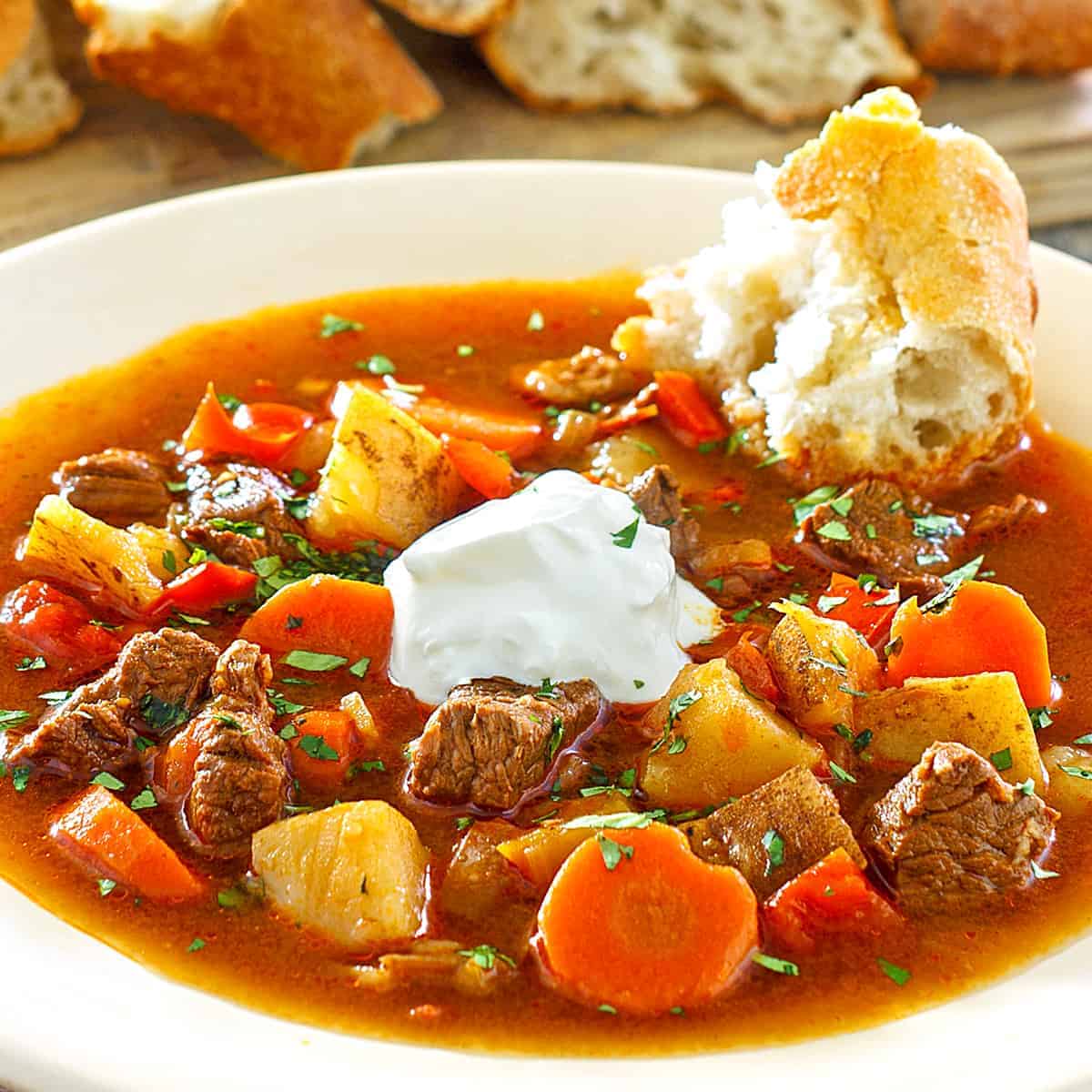
Traditional Hungarian goulash is a prime example of how a few simple ingredients, cooked properly, can yield an incredible flavor. Though many variations of Hungarian goulash exist, and every cook makes it just a bit differently, this is an authentic recipe from the heart of Hungary.
Hungary holds a special place in my heart and in my family’s hearts. My brother lived there for a couple of years and would always describe its beautiful scenery and architecture and his love for the Hungarian people. When I visited Budapest for the first time I immediately fell in love with it. Its name comes from the two sides of the city (Buda and Pest) separated by the Danube River running through it. With its striking chain bridge, stunning parliament building, and its incredible Buda Castle, Budapest is a breathtaking city.


Hungary’s history has been one of hardship and heartbreak. But the passion and stamina of soul has remained in the hearts of the Hungarian people. I’ve always been touched by Hungary’s national anthem, Himnusz, or “hymn”, written by the poet Kölcsey. Their anthem is a poetic prayer and unlike most anthems that focus on an expression of national pride, the Hungarian anthem is a direct, heartfelt plea to God. In the mid-20th century, during the years of strongest communist rule in Hungary, the words were not sung, only the music was played. The communist government asked two of the most acclaimed artists of that time, a poet and composer, to rewrite the national anthem. Both refused. The next communist leader also tried, unsuccessfully, to have it changed. And so Hungary’s national anthem remains Himnusz and its first three lines read:
O God, bless the nation of Hungary
With your grace and bounty
Extend over it your guarding arm

I also love Hungarian food. Their breads and smoked sausages are fantastic as are their meats, stews, sauces, and desserts. Today I’m going to share the national dish of Hungary: Goulash.
What is Hungarian Goulash?
Contrary to popular belief here in the U.S., Hungarian goulash is NOT made with ground beef or macaroni noodles! Traditional Hungarian goulash is an entirely different dish.
Goulash, or as Hungarians call it, gulyás, means “herdsman.” Its origins date back to the 9th century Magyar shepherds as a simple meat and onion stew prepared in heavy iron kettles known as bogracs. In the 15th century invading Ottoman Turks introduced a new spice to Hungary, paprika. While the rest of Europe remained lukewarm towards this red chili pepper from the New World, Hungary embraced it and paprika has since become a defining element of Hungarian cuisine.
Goulash is kind of in between a soup and a stew. Unlike some stews, Goulash is not overly packed full of beef and vegetables, it is a little more brothy. But through the cooking process, the broth becomes a little thicker and very rich in flavor.
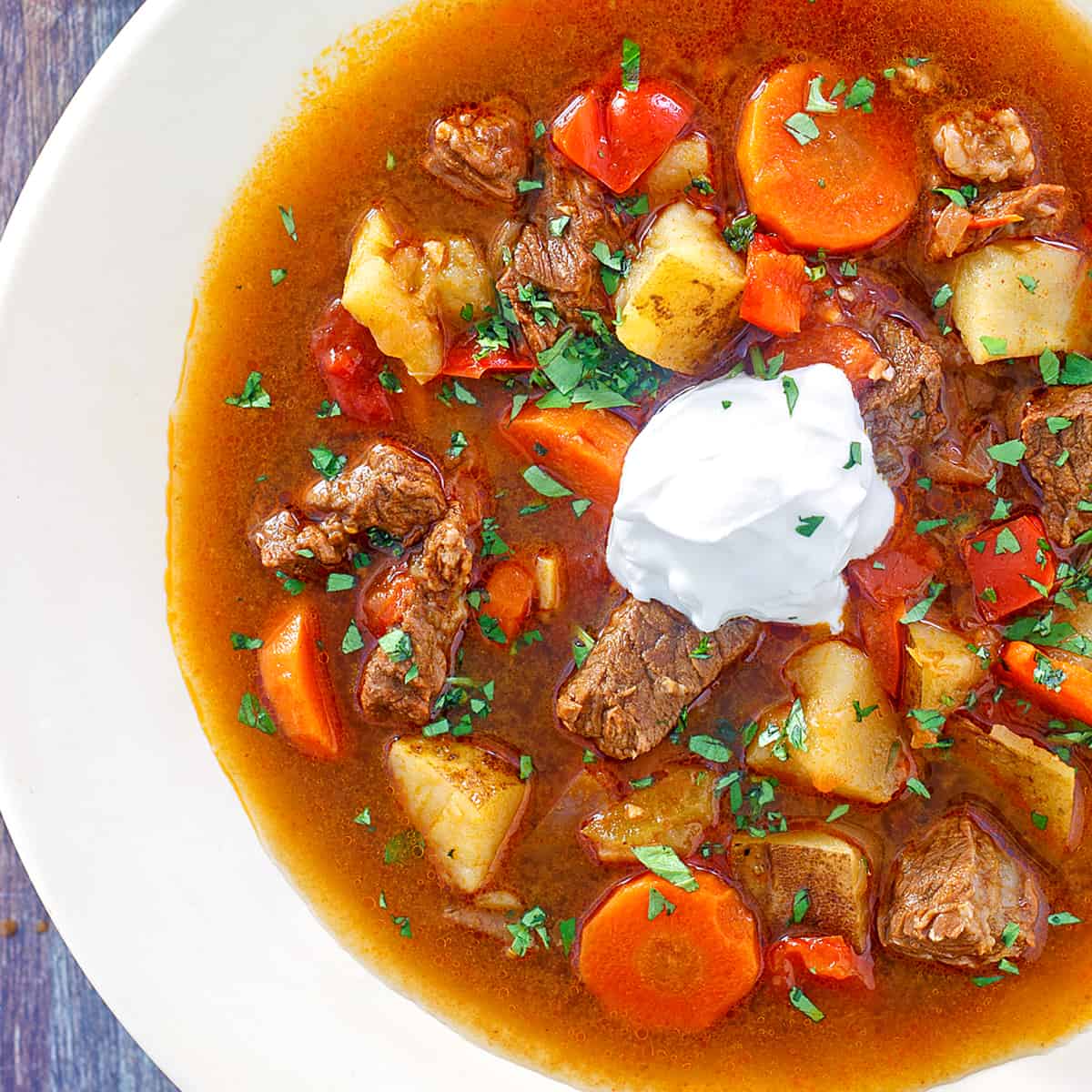
Tips for Authentic Hungarian Goulash
To achieve the ultimate flavor, the cooking method is important and quality, real Hungarian paprika is essential. And lots of it! None of this “2 teaspoons of paprika” jazz. Hungarians use very generous amounts of paprika, and that’s key. A Hungarian once told me, “however much paprika the recipe calls for – at least double or triple it!”
For this size batch of Goulash, you want to use a full 1/4 cup of it. When I lived in Germany, Hungary was just a few hours away and I would stock up on it when I visited. Now I order it online and recommend this genuine imported Hungarian paprika imported from Hungary. There is no comparison in flavor. It has an extraordinarily rich flavor and an exceptionally vibrant red color. Many of our readers have tried it and agree that quality Hungarian-imported paprika makes all the difference.
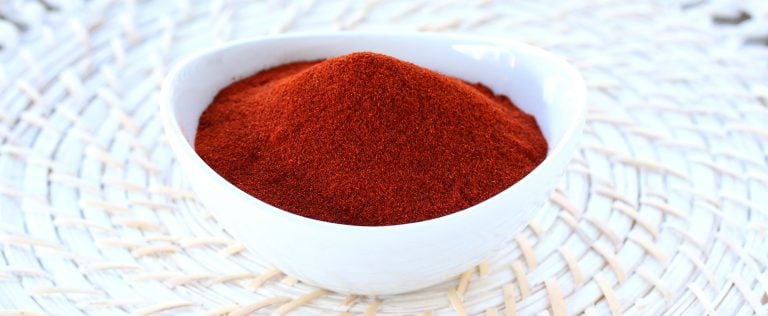
I mentioned earlier, many variations of goulash exist. Some include turnip or wine or caraway seeds, to name a few. But this recipe is a very old, very traditional way of making Goulash that my brother and I learned from older generations of Hungarian women and it needs no embellishments. It’s simple and simply delicious!
What’s the Best Dutch Oven to Use?
For this recipe, I recommend using a Dutch oven because it seals in the flavors and heats evenly, ensuring consistent cooking results. I love this 6-quart, budget-friendly option from Lodge, which you can get on Amazon for around $80. Or, if you’re looking for a worthy splurge, I also have this one from Le Creuset, which sells for around $300.
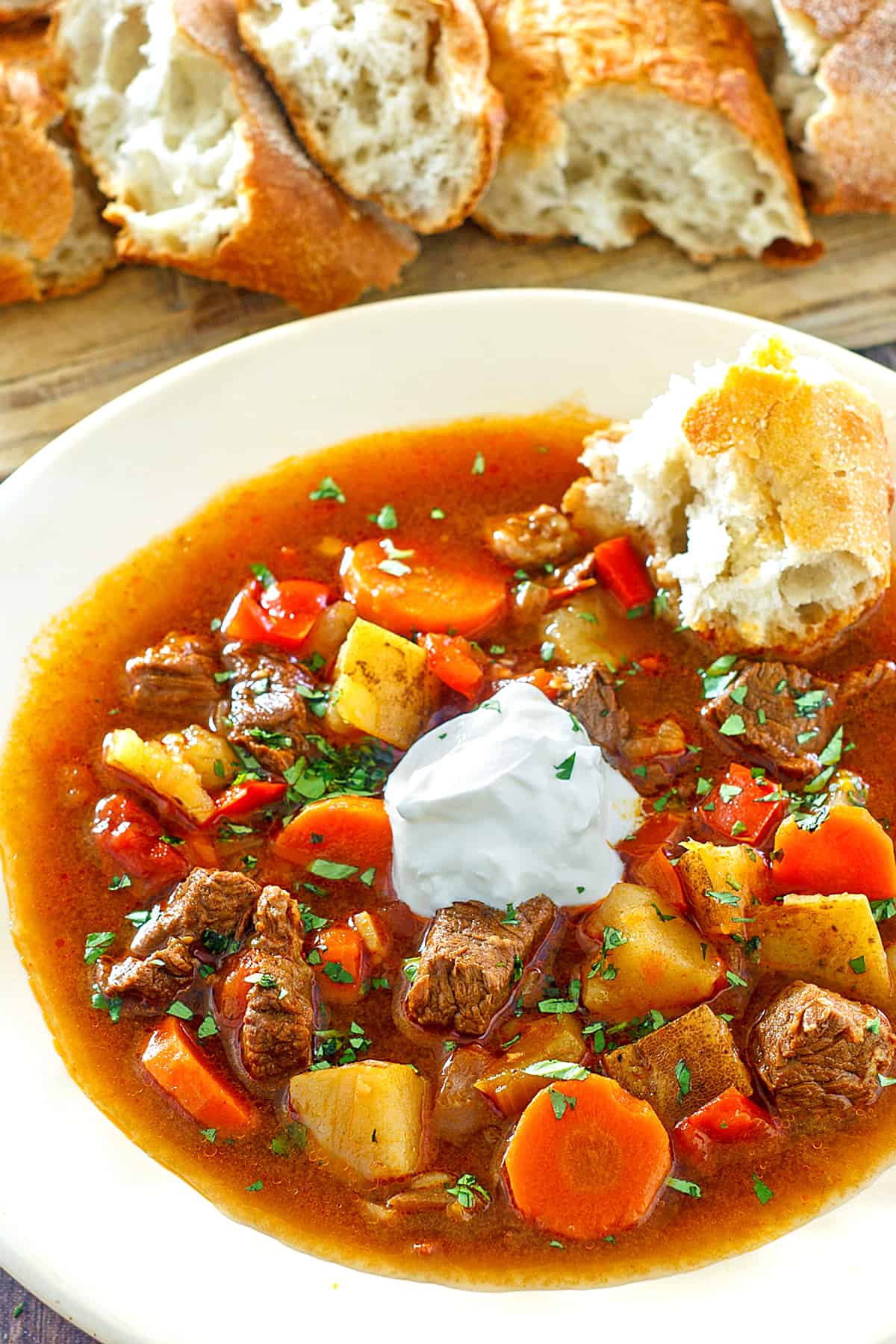
Hungarian Goulash Recipe
Let’s get started!
Melt the lard or butter/oil in a Dutch oven or other heavy soup pot over medium high heat and cook the onions until beginning to brown, about 7-10 minutes. Add the beef and cook until the beef is just starting to brown, 7-10 minutes.
Add the bell peppers, tomatoes, and garlic and cook for another 6-8 minutes. (Note about peppers: Outside of Hungary it’s very difficult to find the peppers they use there. The best ones to use in their place are red and some yellow/orange. Avoid regular green bell peppers as they have a starkly different flavor profile.)
Remove the pot from the heat and stir in the paprika, salt, pepper and caraway (if using) (note: paprika becomes bitter if at all scorched).
Add the beef broth, bay leaf, return to the stove and bring to a boil. Reduce the heat to medium, cover and simmer for 40 minutes. Add the carrots and potatoes. Return to a boil, reduce the heat to medium, cover, and simmer for another 30-40 minutes or until the beef is nice and tender. Add salt to taste. Remove the bay leaf.
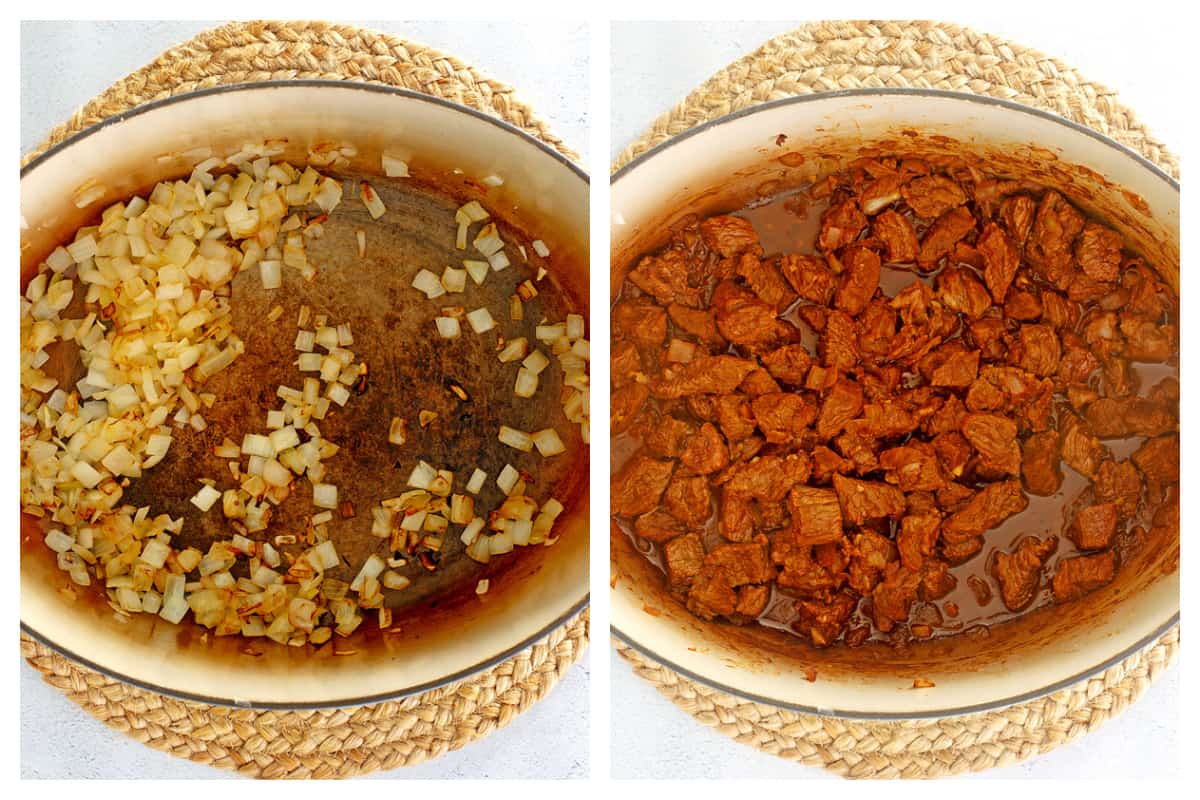
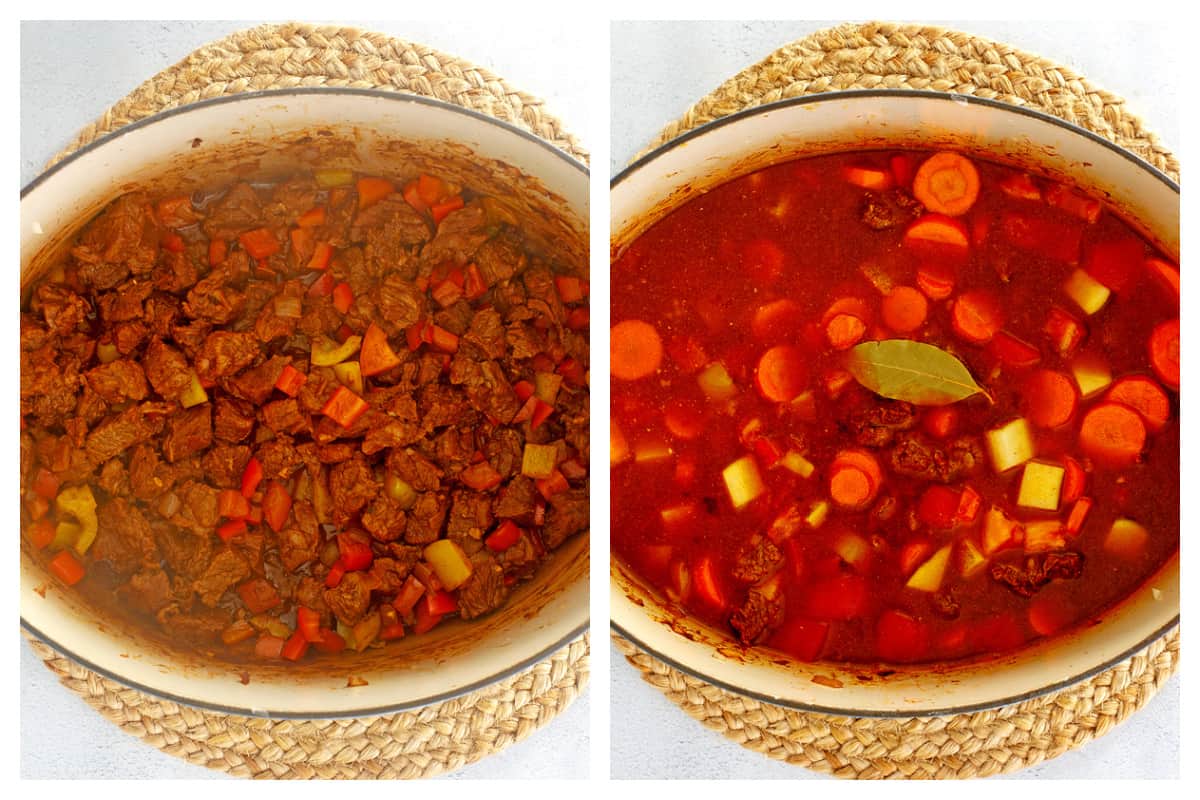
Serve with some crusty bread and, if desired, a dollop of sour cream.
Enjoy!
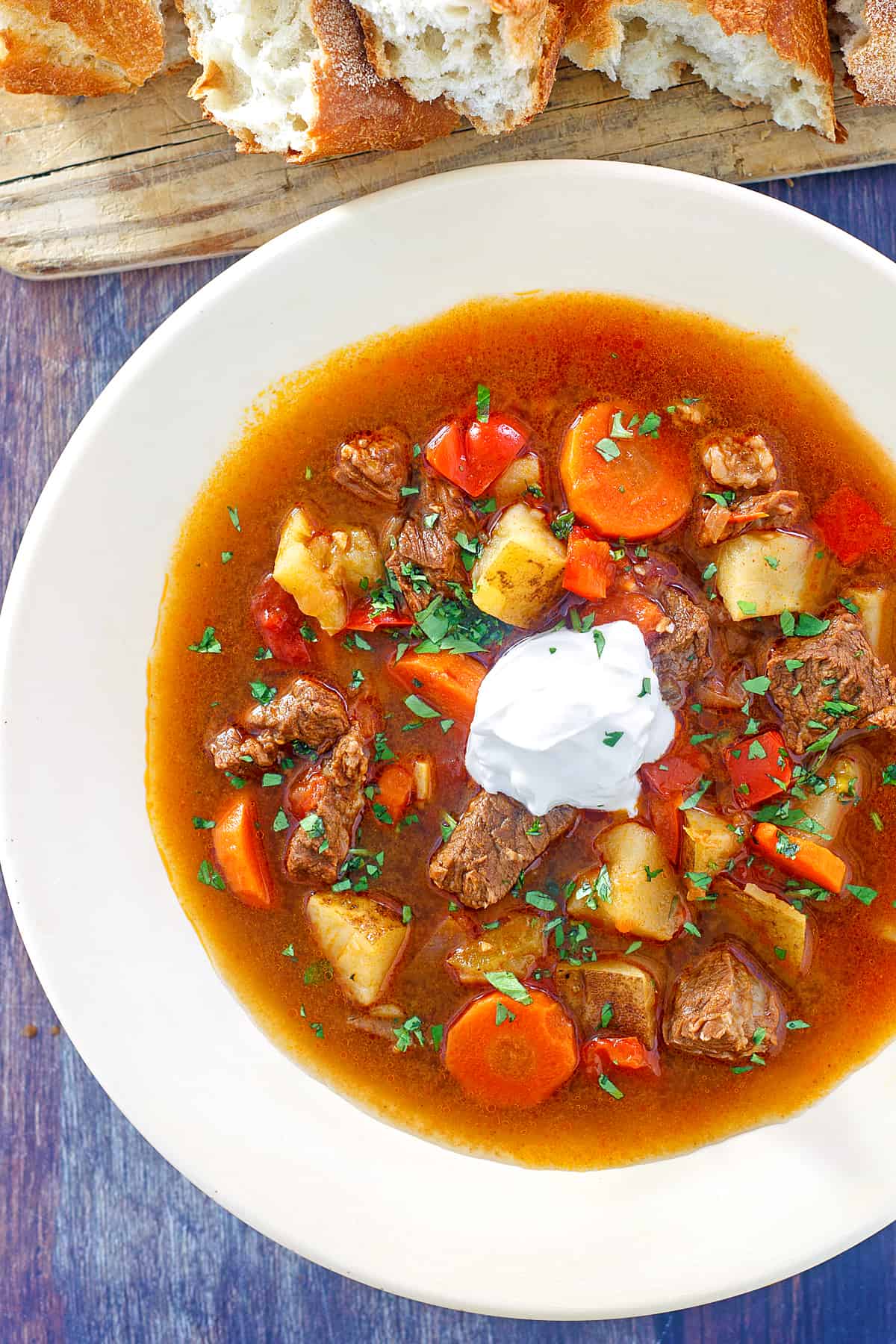
For more authentic Hungarian dishes, be sure to try my:
Save This Recipe
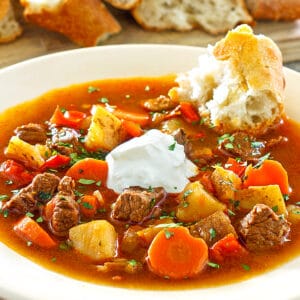
Authentic Hungarian Goulash (Gulyás)
Ingredients
- 3 tablespoons pork lard , or butter or bacon grease (pork lard is traditionally used and imparts a great flavor)
- 1 1/2 pounds yellow onions chopped
- 1/4 cup quality genuine imported Hungarian sweet paprika
- 1 1/2 pounds stewing beef , cut into 1/2 inch pieces
- 5 cloves garlic ,minced
- 2 red bell peppers ,seeded/membranes removed, cut into 1/2 inch chunks
- 1 yellow bell pepper ,seeded/membranes removed, cut into 1/2 inch chunks
- 2 tomatoes ,diced
- 2 carrots ,diced
- 2 medium potatoes ,cut into 1/2 inch chunks
- 5 cups beef broth (traditionally just water is used but beef broth adds so much more flavor)
- 1 bay leaf
- 1 teaspoon salt
- 1/2 teaspoon freshly ground black pepper
- 1/2 teaspoon crushed caraway seeds (optional, not traditional in all regions)
Instructions
- Melt the pork lard or butter/oil in a Dutch oven or other heavy soup pot over medium high heat and cook the onions until beginning to brown, about 7-10 minutes. Add the beef and cook until the beef is just starting to brown, 7-10 minutes. Add the bell peppers, tomatoes, and garlic and cook for another 6-8 minutes. Remove the pot from the heat and stir in the paprika, salt, pepper and caraway (if using) (note: paprika becomes bitter if at all scorched). Add the beef broth, bay leaf, return to the stove and bring to a boil. Reduce the heat to medium, cover and simmer for 40 minutes. Add the carrots and potatoes. Return to a boil, reduce the heat to medium, cover, and simmer for another 30-40 minutes or until the beef is nice and tender. Add salt to taste. Remove the bay leaf.
Nutrition
Originally published on The Daring Gourmet on March 18, 2014
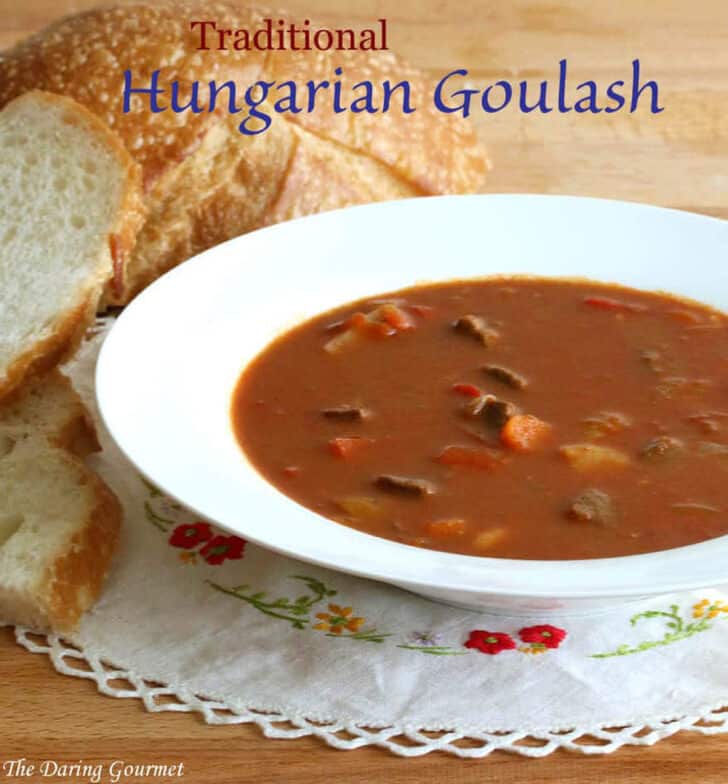



















My grandmother was born in Budapest, Hungary as kids we grew up with my mom and grandmother making goulash and this is about as close to their’s as I’ve had. The Hungarian paprika is the key but 1/2 cup may be to much for some because it’s very strong, I used 1/4 cup as did my mom.
Thank you, Veronica, I’m so glad you enjoyed this and appreciate the feedback. I agree, 1/2 cup of paprika would be extreme. My recipe only calls for 1/4 cup as well.
I tried this recipe (actually mail ordered for Hungarian Paprika) and I have to say… it made me very happy. So happy that I ordered the big bag of Paprika afterwards. This is nothing at all like the American goulash I grew up with. I had authentic Hungarian goulash once as a teen at my friends Hungarian grandparents home. First time since then and reminds of hers. You owe it to yourself to make this. You won’t be sorry.
Thank you so much, SLBradley, I really appreciate the feedback and am happy you enjoyed the goulash!
Top class man…went to Hungarian store to get hungarian paprika..it was well worth it posted I didn’t buy a crusty loaf also…ah well next time
Thank you, Ivan, I’m happy you enjoyed it! :)
I’m simmering my batch now. If the broth is any indication then I’m loving this recipe. It’s been years since I last made Hungarian goulash. I’ve spent many years previous trying to perfect the recipe. I think this might be it.
As a person who was raised thinking that goulash was macaroni and ground beef boiled with a can of crushed tomatoes (sorry), this was so much better than I could have imagined! Thank you so much for posting this!
Tomatoes are NOT authentic to a traditional gulyas. They were relatively unknown in Central European cuisine before the first half of the 20th century. Most of the vegetables besides onion and peppers are modern additions as well. Tasty, for sure…but authentic? Maybe for the past 50-85 years, but definitely not if we’re talking historical gulyas going back to the middle ages.
Hi Epic, there is no claim that this recipe dates back to the Middle Ages.
According to Encyclopedia Brittanica, gulyas origin has been traced back to the 9th century. The Middle ages spanned from the 5th century to the late 15th century, which lands the origin right smack dab in the middle of the Middle ages.
Sure, I’m not disputing that, Perin. I said I make no claim that THIS recipe dates back to the Middle Ages. The gulyas made in the 9th century was vastly different than the gulyas we know today, to the point of bearing little resemblance other than being a stew of meat and onions. One prime example: Paprika – an indispensable ingredient in goulash – wasn’t added until the 18th century.
I made this yesterday and it was amazing! My husband loved it! However, my purist friends of Hungarian descent are giving me a hard time about the peppers and authenticity. Can you source this recipe for me, or is this a recipe that you developed yourself? It’s funny how sensitive foodies can be;).
It is honestly the best Gulyas I’ve ever tasted, ever made. Thank you for sharing it.
Thank you, Heather, I’m thrilled that you enjoyed it and appreciate the feedback! Peppers are very much an authentic component in traditional gulyas (that’s Hungarian wax peppers, not the bell peppers we have to substitute with). That said, ingredients also vary not only from region to region but from family to family. My advice to your friends would be to not limit their notions of authenticity to whatever family recipes they may have or whatever restaurants they may have dined at if they’ve ever visited Hungary. The best proof of authenticity is to eat far and wide in Hungary versus dining at the tourist-oriented restaurants of Budapest and also to talk to older generation Hungarian home cooks in Hungary and learn from them how they make it and how their parents and grandparents made it. That’s how I learned to make gulyas.
Made this for a family reunion and it was amazing. Searing the meat is key. Served with buttered noodles that were sprinkled with a little dill. Cooked gulyas about 4 hours. My cousins and Godson helped. So rich and thick. House smelled amazing. Just like the old days. It pays to use the good, authentic paprika. Keep it in freezer. It lasts forever.
Wonderful, Elyse, thank you so much for the feedback, I’m thrilled that everyone enjoyed it!